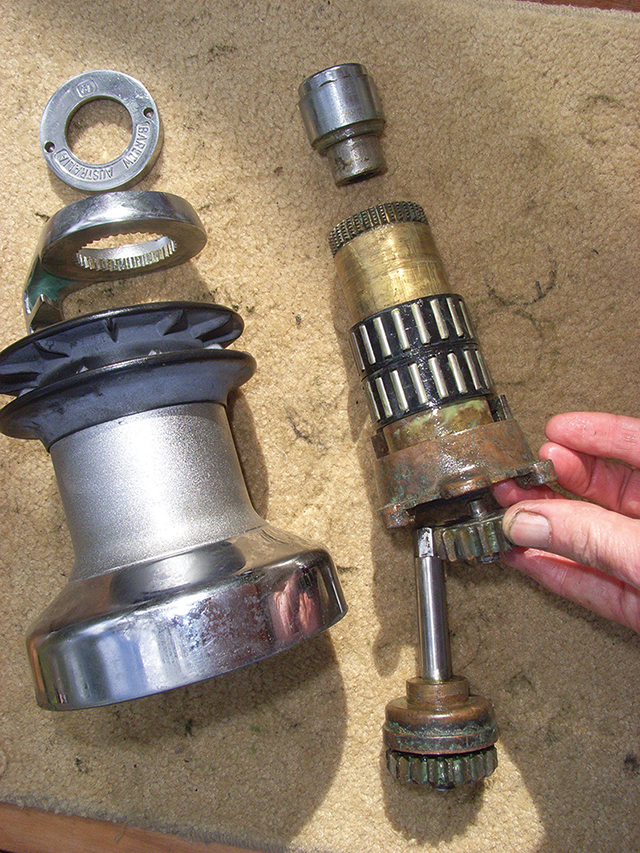Five simple steps can extend the life of one of your most valuable sailing tools (published February 2013)
My wife and I regularly sail together, and while we are still reasonably healthy for our age, we need help controlling the sheets and halyards, particularly when the wind gets up. This help comes in the form of winches that provide a mechanical advantage to control heavy loads. While winches are relatively simple, all need regular care to continue working reliably; ignoring this not only guarantees failure at a crucial time, but eventually costs more money.
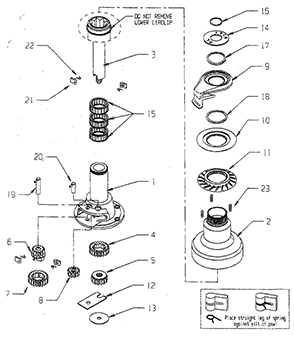 Winch maintenance is cheap and simple, requiring little more than regular cleaning and lubrication, but many people are put off by the seeming complexity of the job. There are a few things that will make the task easier. The first and most obvious is not to leave the job until it is too late. Even though the photos and diagrams I include with this article are of Barlow winches, most other brands will be similar.
Winch maintenance is cheap and simple, requiring little more than regular cleaning and lubrication, but many people are put off by the seeming complexity of the job. There are a few things that will make the task easier. The first and most obvious is not to leave the job until it is too late. Even though the photos and diagrams I include with this article are of Barlow winches, most other brands will be similar.
STEP ONE
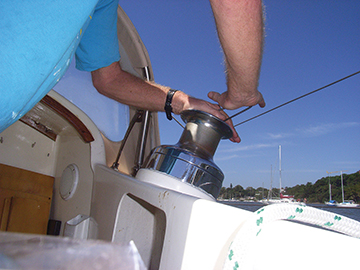
First, remove the winch drum. This heart-stopping maneuver must be achieved without putting anything under the water; select a calm day away from passing traffic—not always easy on a busy harbor. Tie towels or stiff cardboard along the safety lines to hopefully trap loose bits; don’t forget to cover the deck drains, too.
Barlow winches require a special tool to remove the top nut on the drum. This is a simple bent-wire spanner that fits into two 5mm (3/8 inch) diameter holes in the nut. If you do not have this tool, place a small screwdriver into one of the two holes. Insert the winch handle and turn the handle counterclockwise against the screwdriver; reverse to tighten it. If the nut has seized, wash all traces of salt out, then soak with penetrating oil to remove.
The drums on the smaller winches are secured by a machine screw with either a slotted or Allen key head. Carefully remove the rope jaws and stripper arm first from self-tailing winches. Lift the drum from the base. Be careful, as stuck bearings can suddenly fall when most inconvenient. Unscrew any retaining screws from the base to remove the gear assembly. At this point I like to remove the whole operation to the security of the cabin, covering the table with a piece of carpet to trap small pieces and absorb grease and oil.
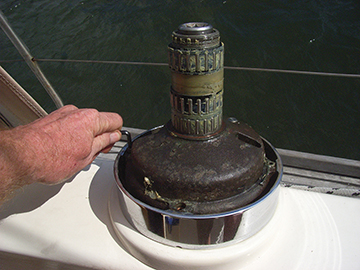
STEP TWO
Next, remove bearings and sleeves from the main shaft. Lay the pieces out in the order they are removed so is easier to reassemble afterwards. Unless you have the exploded drawing, use a digital camera to take a few photos so reassembly is simplified and you have a reference for next time.
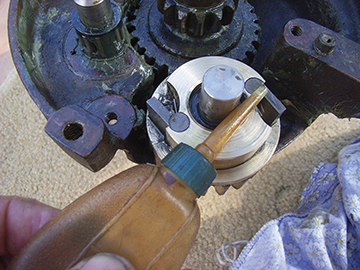
Locate the ratchet pawls. There will be two pairs on two-speed winches; one engages the high gear, the other the low gear. On a single speed winch, expect only one pair. The pawls are retained in the gear socket by a small spring; these are easily lost. Keep a plentiful supply of springs and pawls, as they are inexpensive and the winch is useless without them. Also keep a supply of any clips or screws specific to your winches. Note where washers are fitted as gear spacing is important. If your winch has sprung rope-jaws, remove these. Undo all retaining screws evenly and lift off the top plate together with the retaining screws, remembering where any locating lugs are positioned. Next, remove springs and any spacers or locators, then remove and separate the complete assembly. Inspect the assembly for wear. When reassembling the jaws, carefully fit locating lugs in their original place.
STEP THREE
Now, wash all parts in kerosene, white spirit or even diesel oil if this is all that is available. Allow them to air dry or wipe with a clean, lint-free cloth. Once all is clean and dry (do not forget the inside of the drum) examine each part carefully for wear or damage. Distorted parts, loose fitting or bent shafts will need replacing, as will chipped or worn gears or bearings. Ratchet pawls will eventually wear the gear socket, so check these for excessive play; if the socket is worn, the only remedy is a new gear.
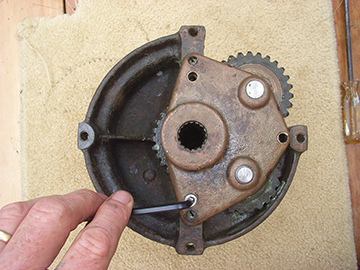
STEP FOUR
Lubricate the parts using a light, waterproof grease similar to that used for machinery in food preparation. Petroleum jelly (Vaseline) is suitable, although I have found this runs in hot weather; avoid Teflon greases. When lubricating bearings, force the grease into the rollers. Be sure they are fully covered, but do not get carried away—too much grease is as bad as not enough. Only lubricate the pawls and springs with light machine oil (three in one). Avoid getting grease into these as it can cause them to stick.
STEP FIVE
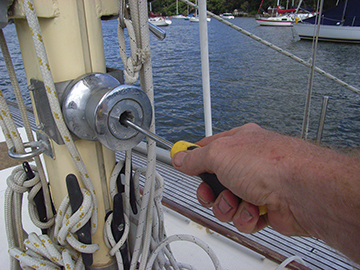
Putting everything back together is where those diagrams and photos become worth the effort. Most parts are difficult to assemble incorrectly, but take care with pawls and springs; the winch may slip under load if these have been installed incorrectly (see photo). To fit gears, rotate slowly in the direction that closes the pawls using only finger pressure. If you have two similar winches, service each one separately—it might help to refer to its twin. Check that all screws and bolts are tight and that each part rotates smoothly with the pawls ticking like an old watch. Once the winch is fully assembled, test again before putting it under heavy load.
In the marine environment, water and salt are our biggest enemies. Regular rinsing with fresh water can remove much of the salt and extend the life of the winch. While most suppliers recommend cleaning and lubricating winches every three months for heavy use, I find six to 12 months more realistic. Once over the initial reluctance to tackle the job, it is reassuring to know that not only are your winches in good order, but you now have the knowledge to repair them when away cruising.
John Tylor is a retired electrical engineer who lives in the Blue Mountains west of Sydney, Australia. He and his wife Patsy cruise the east coast of Australia when they can, but he is currently upgrading their venerable Duncanson 35 yacht Ard Righ (‘The High King’ in the Celtic language). John has repaired the electrics on many yachts and gains inspiration from these experiences as well as from the many upgrades to his own boat.
















